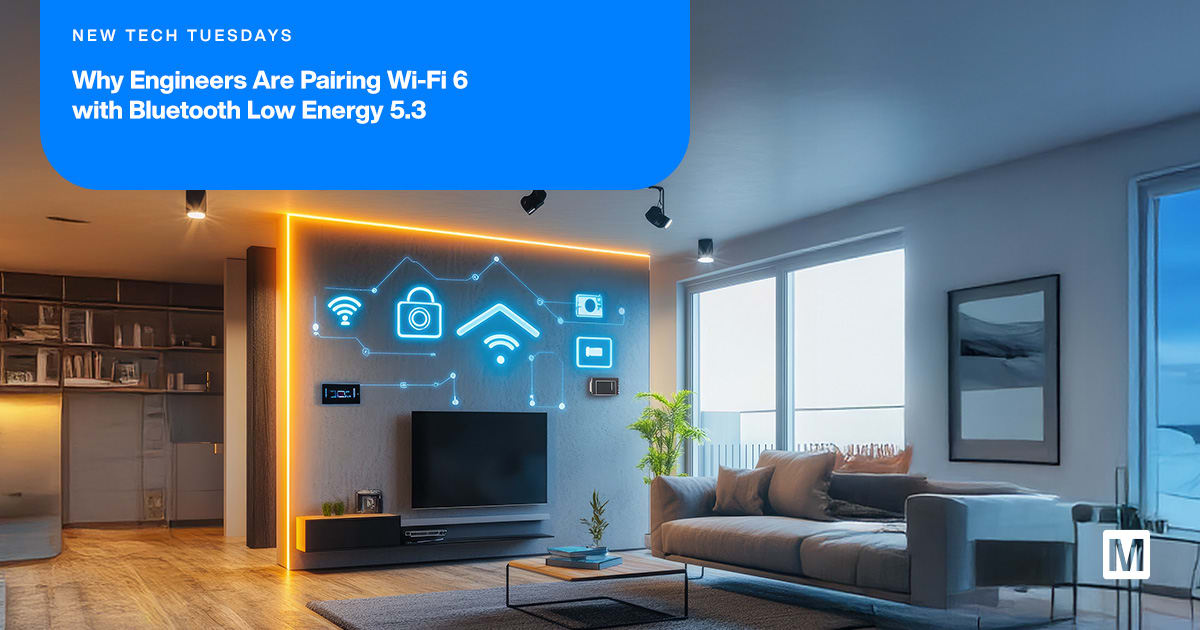Why Engineers Are Pairing Wi-Fi 6 with Bluetooth Low Energy 5.3

New Tech Tuesdays
Join Mouser's Technical Content team for a weekly look at all things interesting, new, and noteworthy for design engineers.
Published September 30, 2025
Every connected product starts with the same question: how does the device stay connected without draining the battery?
Engineers face this challenge when developing products like smart locks, industrial trackers, wearable health sensors, and everything in between. That’s why the combination of Wi-Fi 6 (IEEE 802.11ax) and Bluetooth® Low Energy 5.3 is quickly becoming the norm for wireless design. This pairing offers fast cloud updates when you need them and ultra-low-power local control when you do not.
These two wireless standards were once kept separate by power budgets and design complexity, but can now coexist on the same board. Wi-Fi 6 brings higher speeds, better performance in congested environments, and built-in power-saving features like target wake time (TWT). Bluetooth Low Energy 5.3 extends range, improves throughput, and enables smoother peripheral communication, all while consuming minimal power.
Together, they give engineers the best of both worlds: fast cloud access when needed, and a battery-friendly link for close-range communication. And now, thanks to integrated solutions, engineers do not have to juggle two RF stacks or fight for board space to gain these advantages.
In this week’s New Tech Tuesdays, we explore how Wi-Fi 6 and Bluetooth Low Energy 5.3 are reshaping smart, connected devices by offering fast cloud sync and ultra-low-power control in one dual-radio solution.
Simplifying Wireless Design
Boards that merge Wi-Fi 6 and Bluetooth Low Energy 5.3 solve several integration pain points:
- Simplified RF design: Pre-certified front-end and matching networks reduce layout complexity and risk.
- Single firmware toolchain: Running both radios through one MCU interface saves flash/RAM and development time.
- Secure, over-the-air (OTA) ready: Wi-Fi updates and secure Bluetooth pairing make connected devices more reliable.
- Scalable prototyping: With USB power and familiar ports like M.2 or Arduino headers, engineers can prototype faster.
Integration Considerations
Designing for both Wi-Fi and Bluetooth Low Energy used to mean compromising between performance, layout complexity, and firmware stability, but now integrated platforms that combine both help solve many of these challenges. However, there are still some key factors engineers need to keep in mind.
Power Management
Wi-Fi 6 helps reduce power use with features like TWT, but it still consumes more energy than Bluetooth Low Energy. A smart approach is to let Bluetooth Low Energy handle the frequent, low-power tasks nearby and reserve Wi-Fi for bulk transfers, updates, or cloud sync.[1]
RF Coexistence
Using both Wi-Fi and Bluetooth in the same 2.4GHz band can cause signal problems if not managed well. Newer systems typically include antenna switching, shared clocks, or time-slicing protocols so they can exist without collisions or signal degradation.
Firmware Coherence
Using one software system for both Wi-Fi and Bluetooth keeps things simple and saves memory. Engineers should look for software development kits (SDKs) or firmware platforms that support multi-protocol operation out of the box, especially with real-time task management.[2]
Certification and Compliance
Using a pre-certified module significantly cuts down on time and costs when going to market. Boards that come with regulatory approvals for Wi-Fi 6 and Bluetooth Low Energy 5.3 can save time on testing and avoid design revisions.[3]
How It’s Being Used Today
In smart home, wearable, and industrial applications, combining Bluetooth Low Energy with Wi-Fi 6 has transitioned from an idea into practice.
Smart Home Devices
Today’s smart locks, thermostats, and modern home appliances often use Bluetooth Low Energy for quick, energy-efficient tasks, like pairing with a smartphone or accepting commands from a nearby device. At the same time, Wi-Fi 6 handles cloud services like real-time status updates, firmware pushes, usage analytics, maintenance notifications, or remote control when the user is away.
Wearables and Health Tech
Fitness trackers, smartwatches, and health monitors often sync step counts, sleep data, or heart rate trends using Bluetooth Low Energy in the background. Then, when the device is docked or charging, it offloads bulk data over Wi-Fi 6, so users get secure uploads, OTA updates, and remote diagnostics without draining the battery throughout the day.[4]
Industrial Sensors and Gateways
Modern factories rely on wireless sensors to monitor everything from machine health to environmental conditions. Smart factories today are using dual-radio edge nodes in predictive maintenance, where sensors track vibration or temperature and send data to the cloud when needing to conserve power. These sensors usually communicate using Bluetooth Low Energy for local, power-efficient data gathering. This can be either in a mesh network or point-to-point. Then, to deliver collected data, issue remote updates, or send alerts to the cloud, the system switches to Wi-Fi 6 because of its higher throughput and lower latency for bulk transfers.[5]
The Newest Products for Your Newest Designs®
This week’s New Tech Tuesdays features the STMicroelectronics X-NUCLEO-67W61M1 expansion board. Part of ST’s STM32 Nucleo ecosystem, this board combines Wi-Fi 6 and Bluetooth Low Energy 5.3 for low-power, dual-radio prototyping. Built around the ST67W611M1 coprocessor Wi-Fi module, it supports SPI host interfacing through Arduino® Uno R3 headers.
Designed for fast development, the board is supported by the X-CUBE-ST67W61 expansion software package for STM32Cube, which offers ready-to-use drivers and reference examples for creating applications such as MQTT, HTTP/HTTPS client and server, and Bluetooth Low Energy peer-to-peer (p2p) and commissioning.
Tuesday’s Takeaway
As connected devices get smaller, smarter, and more power-conscious, combining Wi-Fi 6 and Bluetooth Low Energy 5.3 is a strategic move. These dual-radio setups let devices handle short-range tasks and cloud communication without overwhelming the battery or design. And with pre-certified boards and streamlined software tools, engineers can move from ideas to prototypes with fewer limitations.
Sources
[1]https://www.renesas.com/en/blogs/low-power-advantage-wi-fi-66e-twt-explained?srsltid=AfmBOorB_ND0CmsQFN_PtFwy4mB19pICpUToX3hJ31s10-BO9UUwewPw
[2]https://www.silabs.com/documents/public/application-notes/an1128-bluetooth-coexistence-with-wifi.pdf
[3]https://punchthrough.com/ble-module-vs-chip-down
[4]https://media.withings.com/kits/guides/2023/scanwatch-2/AW_PRODUCT_GUIDE_US_RX_HWA10_A.pdf
[5]https://www.bisinfotech.com/dual-radio-connectivity-best-of-both-worlds-in-iot/